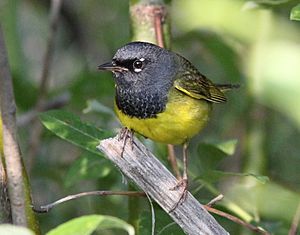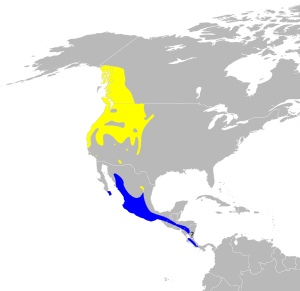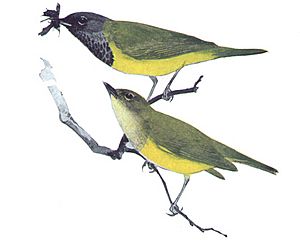MacGillivray's warbler facts for kids
Quick facts for kids MacGillivray's Warbler |
|
|---|---|
 |
|
| male | |
 |
|
| female | |
| Conservation status | |
| Scientific classification | |
| Genus: |
Geothlypis
|
| Species: |
tolmiei
|
 |
|
| Range
breeding overwintering |
|
| Synonyms | |
|
Oporornis tolmiei |
|
MacGillivray's warbler (Geothlypis tolmiei) is a species of New World warbler. These birds are sluggish and heavy warblers, preferring to spend most of their time on, or near the ground, except when singing.
The MacGillivray's warbler was named by John James Audubon in honor of Scottish ornithologist William MacGillivray, although the proper credit to its discovery goes to John Kirk Townsend. The specific name was given in honor of William Fraser Tolmie.
Adult MacGillivray's warblers are an olive-green color on their upperparts and dull yellow below. Males have black heads and breasts, while females and immature birds have drab light gray heads; both males and females have broken white eye-rings. The song is a series of repeated two-note phrases, gradually increasing in volume, ending with two single notes: jeeter jeeter jeeter JEETER JEETER jeet jeet. MacGillivray's warblers are very similar to their eastern counterpart, the mourning warbler, the primary difference between the two species being the mourning warbler's lack of an eye-ring.
Measurements:
- Length: 3.9-5.9 in (10-15 cm)
- Weight: 0.3-0.5 oz (9-13 g)
- Wingspan: 7.5 in (19 cm)
MacGillivray's warblers are migratory and spend their summers in temperate forests in the western United States, and in boreal forests of west Canada. In autumn, these birds migrate to Central America, where they stay in temperate shrublands for the winter.
See also
 In Spanish: Chipe cabecigrís de Tolmie para niños
In Spanish: Chipe cabecigrís de Tolmie para niños



